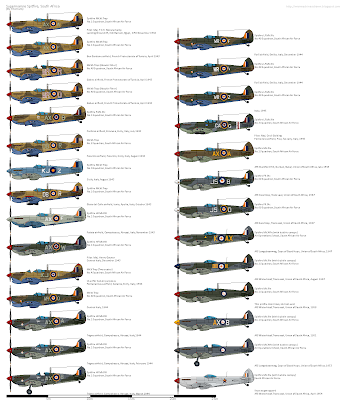The Supermarine Spitfire equipped various squadrons of the South African Air Force (SAAF) during World War 2 and some time after. The following units employed it at some point in their service:
- No.1 Squadron SAAF replaced their Hawker Hurricanes for the Supermarine Spitfire Mk.V in November 1942 after the Battle of El Alamein. They saw action during April 1943 when the Luftwaffe was trying to supply their troops in Tunisia by ferrying supplies with the enormous Messerschmitt Me.323.
In an action that took place on 22nd April, the No.1 Squadron SAAF, together with other squadrons of the SAAF, claimed 16 Me.323 downed and two Italian fighters.
They served through the Sicilian campaign, southern Italy and Anzio. They were present at the Battle of Rome too, claiming 16 enemy aircraft.
They remained in Italy for the rest of the war, operating as a fighter squadron but also flying occasional ground attack sorties. In June 1945 they were intended to transition to the North American P-51 Mustang, however by that time most of the squadron's personnel was returning home and eventually, very few P-51 were delivered.
After the war the squadron was put under No.7 Wing SAAF and was based at AFB Waterkloof, where they flew a mixture of North American Harvard and some Spitfire Mk.IX featuring a bubble canopy.
By 1954 the Spitfires were retired and replaced by the Canadair Sabre Mk.6. - No. 2 Squadron SAAF: From July 1943 until March 1944, this unit operated the Spitfire Mk.Vc during the Italian campaign. From February 1944 until July 1945 they also operated the Spitfire Mk.IXc and served through both Italian and Balkan aerial campaigns. After the war, in December 1948, it was reformed at Waterkloof by being equipped with the bubble-canopy variant of the Spitfire Mk.IX, in order to move over to the North American P-51D Mustang.
- No.4 Squadron SAAF: Just like the previous unit, this one replaced their Kittyhawks with Spitfires in July 1943. In august it was rebased to Sicily and then, in September, to the Italian southern mainland, where it performed mainly aerial and ground attack roles, changing their base various times until the end of the conflict. The unit was disbanded in October 1945 while still in Italy.
It was reformed again in 1951 as part of the Active Citizen Force, when it flew a blend of Harvards and Spitfire Mk.IX, until it was disbanded again in October 1958.
It's worth pointing out that this unit employed a special two-seater ad-hoc variant of the Spitfire intended to be used as a squadron hack during the Italian campaign. - No.3 Squadron SAAF: This squadron received the Spitfire Mk.V while based at Aden, where they also performed coastal patrols over North African shores. In August 1944 it was re-equipped with the Spitfire Mk.IX and was sent to Italy, where it remained until the end of the war, providing ground support. Shortly after the war, it was disbanded.
- No.40 Squadron SAAF: This unit replaced their Curtiss Kittyhawk with Spitfires Vb at the end of February 1943. This variant was equipped with various photographic cameras for tactical reconnaissance duties.
Operating from Malta in June 1943 they took part in various recon flights over Sicily in preparation for Operation Husky, the Allied invasion of Sicily, after which, they served through the Italian campaign, before being re-equipped with the Spitfire Mk.IXc. For the remaining of the year 'A' Flight operated in the Italian Adriatic area, while the remaining of the squadron remained in Egypt, where they were rebased in order to be re-equipped with the Spitfire Mk.IX. In mid January 1944 the whole was reunited again, albeit not for a long time.
'A' Flight took part on the Allied advance over Rome during June-July 1944, as they were attached to the US 5th Army. One detachment was sent to Corsica to take part in the invasion of the Italian island of Elba, an important objective in preparation of Operation Anvil, the invasion of southern France. On 25th August the squadron was re-attached to the British 8th Army and they took part on the assault on the Gothic Line suffering heavy casualties at the Battles of Gemmano and Rimini. I autumn they were rebased to Forli.
A detachment of this unit, flying Spitfire Mk.Vbs saw action against Greek ELAs forces during the early days of the Greek Civil War.
After the war the unit was disbanded. - No. 60 Squadron SAAF: Apparently one detachment of this unit employed some reconnaissance Spitfires after the war, based at Swartkop.
- Air Operations School: Employed some bubble-canopied Spitfire Mk.IXs as advanced trainers.
Sources:
1st https://en.wikipedia.org/wiki/South_African_Air_Force
2nd https://en.wikipedia.org/wiki/1_Squadron_SAAF
3rd https://en.wikipedia.org/wiki/3_Squadron_SAAF
4th https://en.wikipedia.org/wiki/40_Squadron_SAAF
5th https://en.wikipedia.org/wiki/60_Squadron_SAAF
6th https://en.wikipedia.org/wiki/2_Squadron_SAAF
7th https://en.wikipedia.org/wiki/4_Squadron_SAAF
8th https://www.saairforce.co.za/the-airforce/squadrons/1/2-squadron
9th https://www.saairforce.co.za/the-airforce/squadrons/21/4-squadron
10th https://www.saairforce.co.za/the-airforce/squadrons/20/3-squadron
11th https://www.saairforce.co.za/the-airforce/squadrons/12/60-squadron
12th https://www.saairforce.co.za/the-airforce/squadrons/91/air-force-command-and-control-school


No comments:
Post a Comment